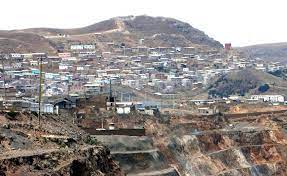Peru is now the world's second leading producer of silver, fifth of gold, and third of copper and zinc. It is truly a multi-mineral mining country, with many hundreds of ventures in the high Andes, in the eastern desert areas, and the jungle. One of the largest operations is in the town of Cerro de Pasco in the central mountains, where mineral in many forms has been transported by rail to the port of Callao for over a century. The Cerro de Pasco Corporation operated for many years, then Centromin took over, a Peruvian government controlled company. When reality led to privatization the Doe Run company was in control.
It was not only the objective to be efficient in running a very complex and large set up, but you have no control over the fluctuations of world prices of minerals. There was an additional task, ... the town was truly contaminated and people were sick. Add the fact that minerals were found under land were people lived and what you have is a very difficult commercial and social challenge.
Having been involved in an administrative capacity with a mining venture in Peru and Panama for about 9 years, I occasionally peak at news of developments here and there.
In 1998 while working for a logistics company I attended a mining trade show in the town of Trujillo, Peru. The star and main speaker of the event was Juan Huayhua, general manager of Doe Run Peru. He was the story of the local engineer that made it good, the highest position for an important foreign investment. After the speech somehow I finish in a group of about 6 people, with Eng. Huayhua. At this time I am questioning what I heard in his speech. The other individuals are very young professionals, just dreaming to be ... someday, just like him.
As Don Jorge would say ... there was in his speech ...
"Una hemorragia de palabras y una anemia de ideas"
I can't really blame him for this ... after all belts come from leather. It was just that my experience told me that those tremendous social challenges in Cerro de Pasco, affecting about 70,000 people, will not be solved. Not even close. Not even close .. again. There was my feeling .... contrasting with this up beat dialogue of the other participants. Good versus evil? Skepticism versus enthusiasm. Experience versus hope ..?
Doe Run Peru eventually gave up the concession and Minera Volcan is the current operator. The news item details what has to be done and it looks like the same old same old monumental challenges. What does my experience tell me now. That you got to have .... hope.
Doe Run Peru eventually gave up the concession and Minera Volcan is the current operator. The news item details what has to be done and it looks like the same old same old monumental challenges. What does my experience tell me now. That you got to have .... hope.

Comments